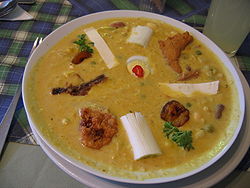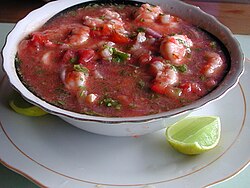
This is a list of Ecuadorian dishes and foods. The cuisine of Ecuador is diverse, varying with altitude, agricultural conditions, and the ethnic and racial makeup of local communities. On the coast, a variety of seafood, grilled steak and chicken are served along with fried plantain, rice and beans. Stewed beef and goat are traditional too. The most traditional seafood dishes are ceviche (shrimp, mussels, oysters, fish, and others) and fish soup. Also, there are a variety of soups based on local vegetables, like sopa de queso (vegetables and white cheese) and caldo de bolas, a soup based on plantains.
Contents
In the mountains the most culturally consensuated dishes are encebollado, hornado and fritada, while in the coast they are ceviche, encebollado and viche . [2] Pork, chicken, beef, and cuy (guinea pig) are served with a variety of carbohydrate-rich foods, especially rice, corn, and potatoes. A popular street food in mountainous regions is hornado (roasted pig), which is often served with llapingacho (a pan-seared potato ball). Some examples of Ecuadorian cuisine in general include patacones (unripe plantains fried in oil, mashed up, and then refried), llapingachos, and seco de chivo (a type of stew made from goat). A wide variety of fresh fruit is available, particularly at lower altitudes, including granadilla, passionfruit, naranjilla , several types of bananas, uvilla, taxo, and tree tomato, along with a drink made from fruits known as the colada or even the colada morada.






